Black jumping monkey
| Black jumping monkey | ||||||||||||
|---|---|---|---|---|---|---|---|---|---|---|---|---|

Black jumper monkey ( Cheracebus lugens ) |
||||||||||||
| Systematics | ||||||||||||
|
||||||||||||
| Scientific name | ||||||||||||
| Cheracebus lugens | ||||||||||||
| ( Humboldt , 1811) |
The black spring monkey ( Cheracebus lugens , Syn .: Callicebus lugens ) is a primate species from the genus of the spring monkey within the family of the sakia monkeys (Pitheciidae). It was formerly considered a subspecies of the collared jumper .
features
Black jumper monkeys, like all jumper monkeys, are relatively small primates with fluffy fur . This is black all over the body, only the hands and a horizontal stripe along the throat are whitish. The tail is longer than the body and bushy, it cannot be used as a prehensile tail. The head is small and rounded.
distribution and habitat
Black jumper monkeys have the northernmost range of all jumper monkeys, it includes southeastern Colombia , southern Venezuela, and northwestern Brazil (states Amazonas and Roraima ). In the north the distribution area extends to the Orinoco , in the south to the Rio Caquetá and the Rio Negro . Forests are their habitat.
Way of life
Not very much is known about the way of life of the black jumper monkeys, probably it corresponds to that of the other jumper monkeys. They are diurnal tree dwellers who move on all fours or jump through the branches. Jumper monkeys live in strictly monogamous family groups consisting of a male, a female and their offspring. These groups live in a fixed territory to which conspecifics are made aware with morning duets. The diet consists of fruits and, to a small extent, seeds, leaves and insects. The father takes an intensive part in raising the young. He carries the young and only gives it to the mother to suckle.
Danger
Black jumper monkeys inhabit a large area that is relatively sparsely populated by humans. According to the IUCN, they are not at risk.
literature
- Thomas Geissmann : Comparative Primatology. Springer-Verlag, Berlin et al. 2003, ISBN 3-540-43645-6 .
- Marc GM van Roosmalen, Tomas van Roosmalen and Russell A. Mittermeier: A Taxonomic Review of the Titi Monkeys, Genus "Callicebus" Thomas 1903, with the description of two new species: "Callicebus bernhardi" and "Callicebus stepehnnashi", from Brazilian Amazonia . In: Neotropical Primates. 10, ISSN 1413-4703 , 2002, pp. 1-52, PDF; 2.84 MB .
- Don E. Wilson, DeeAnn M. Reeder (Eds.): Mammal Species of the World. A taxonomic and geographic Reference. Johns Hopkins University Press, Baltimore MD 2005, ISBN 0-8018-8221-4 .